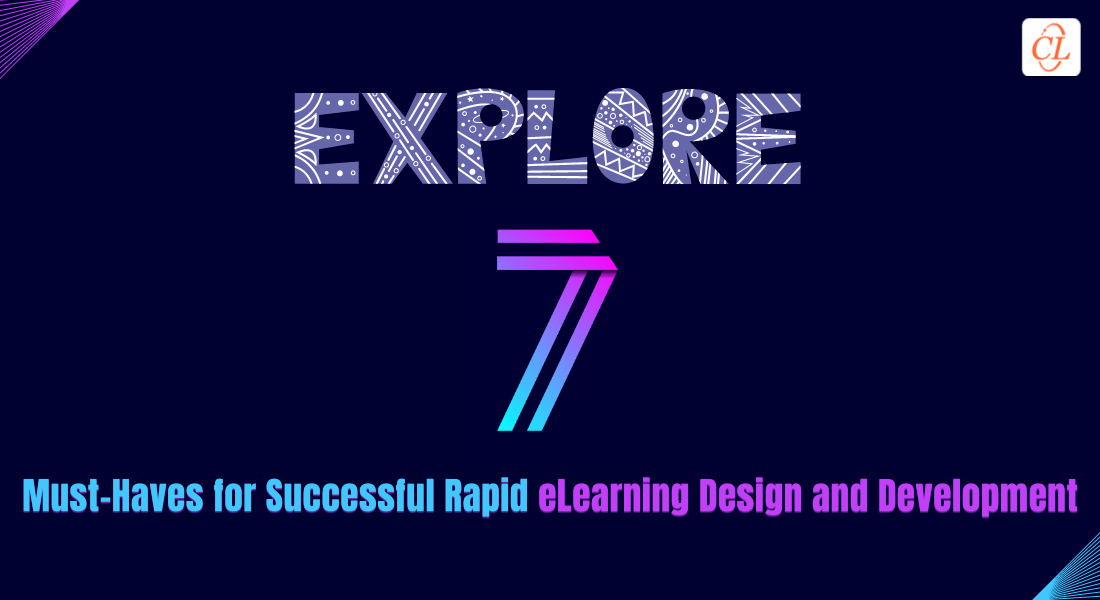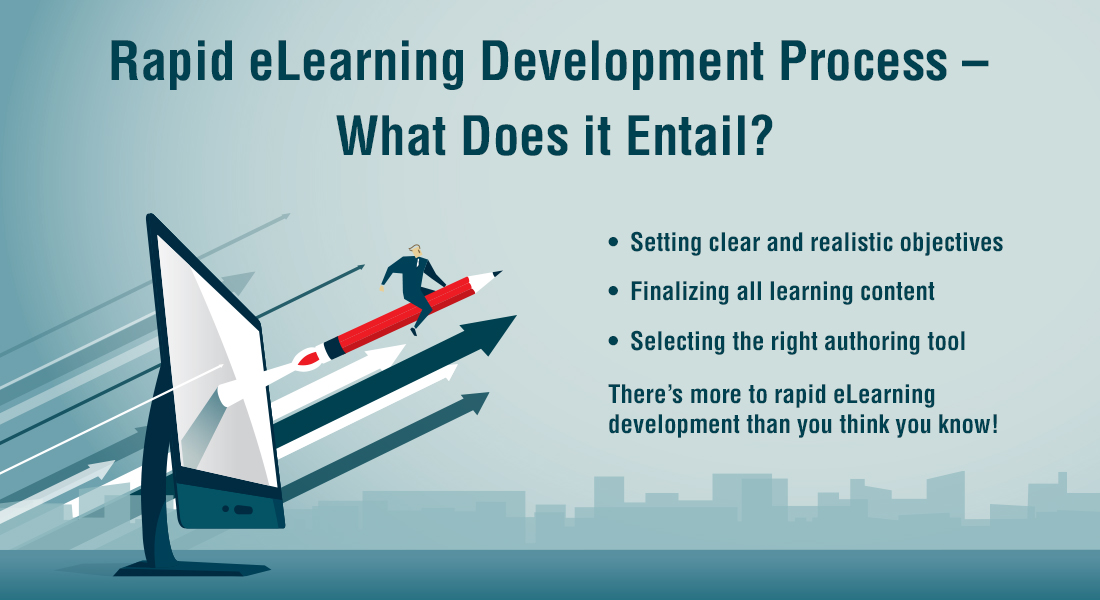5 Key Elements that Accelerate Seamless and Effective Rapid eLearning Development
Rapid eLearning has revolutionized the design and development process to ensure timely delivery and uncompromised quality. Wondering how? In this blog, I'll discuss 5 key elements that ensure a seamless and effective eLearning development process.

Rapid eLearning without speed is like a lion without a roar! As we know, the world of training is constantly evolving with changing business goals. With that said, technology is playing a bigger role in how we learn and access information. And one method that is in the spotlight for its innumerable benefits and, most of all, its competence in assuring fast and timely delivery of eLearning courses is rapid eLearning. It entails the use of modern tools and technology along with instructional design strategies to design and deliver learning content quickly and effectively.
Rapid eLearning Delivers What It Promises!
Here are the five key elements that make it possible:
- Pre-existing content
- Rapid authoring tools
- Agile Processes
- The 4Rs
- Cutting down the extra fluff
But have you ever wondered what is behind the curtains that make it all possible? If yes, then this is the right place for you. In this blog, I’ll discuss some key elements that help accelerate a smooth and seamless process of designing and developing eLearning courses, coupled with an effective and interactive experience for learners. So let’s begin!
5 Elements that Accelerate Seamless and Effective Rapid eLearning
Leveraging Already Existing Content
If you’ve ever tried painting by numbers, you’d know. Drawing a picture from scratch and painting it takes more time than painting a picture that already has its outline ready. Similarly, the pre-existing content makes a good outline for designing and developing rapid eLearning courses. Whether it’s redesigning or rebuilding, leveraging pre-existing content saves a significant amount of time and effort in the eLearning development process.
If you already have a library of training materials that have been used in the past, you can easily adapt and update that content to design and develop new eLearning courses. You can convert your classroom training material to Virtual Instructor-led Training, eLearning courses, or microlearning modules.
Ensure a smooth and effective rapid eLearning development with this informative training manager’s handbook.
Rapid Authoring Tools
To set things straight, rapid authoring tools are the right hand of rapid eLearning. That’s right! They offer strength, reliability, and dependability to the whole rapid eLearning process. These tools are specifically designed to streamline the process of creating and delivering eLearning content, allowing instructional designers and subject matter experts to easily create interactive and engaging learning experiences.
Rapid authoring tools often come with a variety of pre-designed templates and assets, such as graphics, audio, and video, that can be quickly and easily customized to fit the needs of a particular course or lesson. They also typically offer a variety of interactive elements, such as quizzes and games, that can help to keep learners engaged and motivated. All of these features combine to make rapid authoring tools an invaluable tool for anyone looking to create and deliver rapid eLearning in a timely and efficient manner.
Agile Processes
Going back and forth between the phases of eLearning development certainly takes a toll on timely delivery. With that said, the effort and cost involved also suffer significantly. Agile processes offer a respite from all these challenges. Agile processes are a set of principles and practices for managing and completing complex projects in a fast-paced, constantly changing environment. They prioritize flexibility and collaboration among the parties involved. Furthermore, they encourage the use of rapid prototyping and continuous iteration to quickly create and deliver high-quality eLearning courses.
In the context of rapid eLearning, the Successive Approximation Model (SAM) comes in handy. It helps to accelerate the development process and ensures a seamless experience for instructional designers as well as Subject Matter Experts (SMEs). It emphasizes the importance of gathering feedback and making adjustments during the development process itself. This way, it allows for quick course corrections and helps to ensure that the final product is at par with the expectations of the stakeholders. This makes it a valuable tool to ensure seamless and effective rapid eLearning.
The 4R Strategy
The fame of rapid eLearning rests strongly on these 4 pillars — Redesign, Record, Rebuild, and Republish. The 4R strategy of rapid eLearning is an instructional design approach that helps to accelerate the process of creating seamless rapid eLearning. Curious to know how each R of rapid eLearning strategy contributes to the speed and uncompromised quality? Here’s the answer.
The first R, Redesign strategy comes in handy if you have classroom training material available with you. You can easily redesign it to Virtual Instructor-led Training (VILT), eLearning, and microlearning modules. Next, the second R, the Record strategy, is a game-changer when it comes to saving SME time. It significantly reduces the touchpoints between the SME and instructional designer from 9 to 3.
The third R, Rebuild, levels up the rapid eLearning approach as it enables you to reconfigure your lengthy eLearning courses into more easily digestible and retainable microlearning modules. It facilitates learning on the go, and microlearning assets can also be leveraged to provide just-in-time information to the employees, thereby acting as performance support aids.
Lastly, the fourth R, Republish is a life-saver for all your legacy courses. Yes, you read it right. the Republish strategy allows you to reformat your existing eLearning courses that were developed using software that are now obsolete, for example, Flash, and older versions of authoring tools. It provides you with an opportunity to breathe life into your eLearning courses by making them up-to-date and at par with modern learning standards. This facilitates multi-device, multi-browser compatibility, fostering better learner reach. Even better, such courses are easy to translate.
Cutting Down the Extra Fluff
Rapid eLearning gets straight to the heart of the matter. Oftentimes, eLearning courses can become bogged down with unnecessary information or superfluous content that doesn’t really add value for the learner. By cutting away this “fluff,” rapid eLearning streamlines the learning experience and makes it more efficient and effective. Especially when time is of the essence, and you want to ensure that learners are able to absorb and retain the most important information as quickly as possible.
To cut away the extra fluff, rapid eLearning demarcates between need-to-know and nice-to-know content. It focuses on the core learning objectives and prioritizes the content that is most essential to achieving those objectives. By simplifying the content and cutting away the unnecessary elements, rapid eLearning facilitates a more seamless and efficient learning experience for your learners.
Parting Thoughts!
Rapid eLearning definitely saves the day when you need to design and deliver eLearning courses within a short span of time without compromising the content quality. And now you know how! These key elements deserve credit for facilitating a smooth and efficient rapid eLearning development process. Check out the training manager’s handbook for rapid eLearning development to augment the effectiveness of your eLearning courses.





